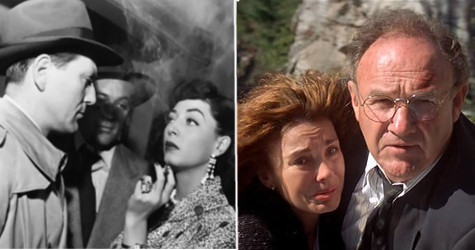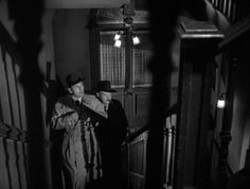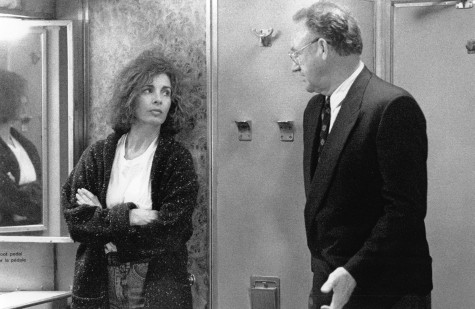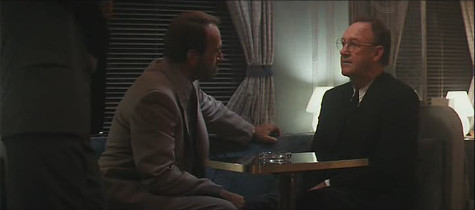
Despite their obvious limitations, trains make great settings for movies.
Think of North by Northwest, where the wrongly charged and hunted Roger Thornhill (Cary Grant) successfully hides in the upper of a Pullman berth, while the porter makes up Eva Marie Saint's berth; the cool blond helping him hide. Or Some Like It Hot, where Genevieve (Tony Curtis) and Sugar Kane (Marilyn Monroe) throw a cocktail party—also in an upper berth. And, there's the near perfect The Lady Vanishes, with Margaret Lockwood, Michael Redgrave, and Dame May Whitty.
While these are great films, the claustrophobic confines of a train seem especially perfect for films noir. One of the best is The Narrow Margin from 1952, remade in 1990. In the 1952 version, Charles McGraw plays the tough-talking, unbribable Det. Sgt. Walter Brown, in a trench coat right out of Bogart's wardrobe. His job is to protect Mrs. Frankie Neall (Marie Windsor), who is planning to testify against the mob. They must go by train from Chicago to Los Angeles.
The noir accents of The Narrow Margin are unmistakable. Near the beginning of the film, when McGraw and his partner are on their way to pick up Windsor, the partner (Don Beddoe) asks McGraw what he knows about the woman. The gravel-voiced McGraw says, “A dish.” “What kind of a dish?” asks Beddoe. “Sixty-cent special: Cheap, flashy, strictly poison under the gravy.” This is a small sample of the great dialogue from Earl Felton's Oscar nominated script.
 Even more noir are the scenes in Windsor's apartment building. The detectives enter the beautifully lit, shadowed foyer, and as the camera precedes the two up the stairs, the spindled staircase on view provides the venetian blind effect so often found in noirs. I'm pretty sure it's a rule, maybe number 3 or 4, right after the dame has to be a femme fatale and the streets must be wet, that a noir is not a noir without venetian blinds. The apartment, too, is filled with the rich, deep shadows only black and white film can offer.
Even more noir are the scenes in Windsor's apartment building. The detectives enter the beautifully lit, shadowed foyer, and as the camera precedes the two up the stairs, the spindled staircase on view provides the venetian blind effect so often found in noirs. I'm pretty sure it's a rule, maybe number 3 or 4, right after the dame has to be a femme fatale and the streets must be wet, that a noir is not a noir without venetian blinds. The apartment, too, is filled with the rich, deep shadows only black and white film can offer.
Marie Windsor makes for a great dame; the first thing she does when she meets McGraw is blow cigarette smoke in his face and ask: Did your “sunburn wear off on your way out” from Los Angeles? From here on out, she is nothing but trouble for McGraw and fun for the viewer. When McGraw's partner dies and Windsor and McGraw get into a cab for the station, he berates himself for not doing more to save his partner, saying, “I'll never forgive myself.” Windsor replies, “Some protection they send me: an old man who walks right into it, and a weeper.” She's a hoot.
When she starts screeching “they promised me protection” after learning that they've been followed onto the train, McGraw says, “Shut up! …Shut up! Do you hear? I've got enough on my mind. It's a rotten detail. I don't like it. I didn't like it from the start. My partner's dead, and it's my fault. He's dead, and you're alive. Some exchange.”
But, Windsor doesn't shut up and keeps getting all the best lines. She also gets the best peignoir, a low-cut black number she puts on for no discernible reason and wears for the rest of the film. The “good girl” in the film, played by Jacqueline White, gets stuck with a buttoned up virgin-white version and only has it on a short while. She’s also stuck with a movie brat (Gordon Gebert—as annoying as he was in Holiday Affair) and gets no decent dialogue or scenes. But then, she’s a wholesome blonde, and, of course, dangerous brunettes get all the fun.
Windsor is tough as nails. When the bad guys target White’s character instead of Windsor, McGraw is uneasy, but it’s just fine with her. “I don't care whether you dreamed up this gag or not,” she tells him. “You're going right along with it, so don't go soft on me…it's your duty, too, even if this dame gets murdered.“
”You make me sick to my stomach,“ says McGraw.
”Well, use your own sink.“
In the 1990 remake, Gene Hackman doesn't get a trench coat, and Anne Archer doesn’t get a peignoir—just jeans and a ratty, baggy sweater she wears for most of the film. Thankfully, she also doesn’t get an annoying kid.

In 1952, lots of people traveled the country by train. Not so much in 1990, so writer-cinematographer-director Peter Hyams does some fancy footwork, placing Archer in the back end of beyond in the Canadian Rockies, so the only way for her and Hackman to escape the killers who come after her is to hop a train.
Though not a film noir, more a generic thriller, the movie does have actual venetian blinds. And, one fabulous-looking scene. Hackman has been contemptuous of Archer, who refuses to risk testifying against a mob boss. Now, it’s time for us to see her side. It’s a familiar scene that the writing does nothing to lift, but visually it is spellbinding.
They sit in a dark compartment; half her face is in darkness, the other side is striped by the shadow of the window blinds. Hackman is nothing but a silhouette: we look over his shoulder, and, for two solid minutes, the scene never once cuts back to him. The only movement is a soft pulse of light as the train passes lamps along the track, an image that recalls the lonely throb of a neon light in a detective movie.
Hyams's dialogue can't hold a candle to Felton's, but it doesn’t have to when he’s got Hackman delivering it. When the two killers, James Sikking and Nigel Bennett, sit down menacingly with Hackman in the club car, he is all nonchalance, his hands resting between his legs. He moves his body as if with the sway of the train, as the other actors do not. Other than sipping once from a coffee cup, he never moves for almost five minutes of screen time. When Sikking offers Hackman a bribe and Hackman refuses, Sikking says, ”I suppose there are two reasons why somebody remains a deputy district attorney. You're either rich, or you're afraid to go out on your own.“

Hackman turns on that contemptuous/affable thing he does that nobody else can match. ”No, no—there's a third reason, too. I don't like people like you. And I really don't like people like your boss. I enjoy putting you away. I really do” (he laughs that great small Hackman laugh). “If I wanted to make money, I'd have to defend you, and that wouldn't be any fun. You know, I'd always feel like I needed a shower. Yeah, I enjoy sitting in the courtroom looking across as the judge passes sentence as your shirt collar starts to get a little too tight” (he yanks on his collar to demonstrate and laughs small). “I'm going to love sitting there watching Leo Watts. I like my side of the courtroom. The pay's not so good, but the air is a lot better.” Pedestrian dialogue, but Hackman makes it great.
The denouement is a lot of fun. Hackman, Archer, and two assassins scrabbling around on top of a train racing through mountain tunnels—an exciting climax to a mostly dull film.
Both movies are worth watching or re-watching if it's been awhile. The 1952 version for the great dialogue and gorgeous black and white photography, the 1990 remake for Gene Hackman.
Susan Amper, author of How to Write About Edgar Allan Poe, still mourns the loss of her Nancy Drew collection.

The 1952 version is a must see for all noir fans.
Hackman definitely elevates all material. Time for a rewatch!